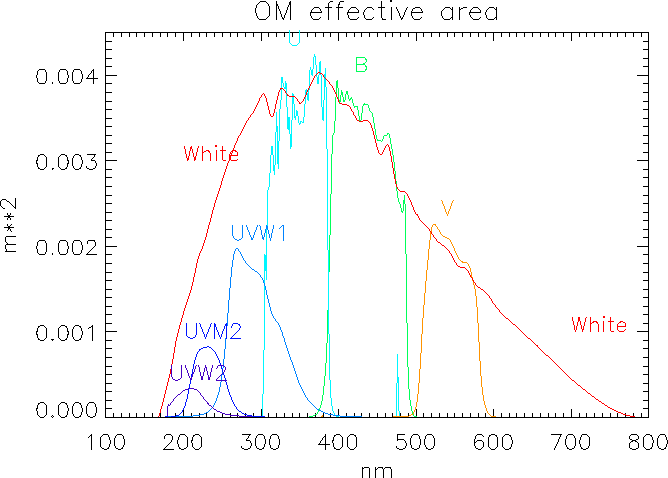Next: 3.5.3.2 OM grisms Up: 3.5.3 OM optical elements Previous: 3.5.3 OM optical elements
The OM set of filters covers part of the UV and optical range. The filter throughput curves are displayed in Fig. 102.
The plotted quantity is the OM effective area for a given filter including the entire telescope response based on inflight measurements. Aperture radius is 6" for the optical and 17".5 for the UV filters.
The OM effective area has been corrected for time dependent sensitivity degradation. The current throughput is lower due to time dependent sensitivity degradation  it was about (16, 7, 8, 13, 19, 22) percent for
(V, B, U, UVW1, UVM2, UVW2) filters, respectively, in 2020 and is currently declining by less than
it was about (16, 7, 8, 13, 19, 22) percent for
(V, B, U, UVW1, UVM2, UVW2) filters, respectively, in 2020 and is currently declining by less than  a year in all filters. The time dependent sensitivity degradation correction for any observing epoch can be found in the corresponding CCF (OM_PHOTTONAT_0008.CCF, see XMM-CCF-REL-378
and references therein).
a year in all filters. The time dependent sensitivity degradation correction for any observing epoch can be found in the corresponding CCF (OM_PHOTTONAT_0008.CCF, see XMM-CCF-REL-378
and references therein).
The principal characteristics of the OM filters are listed in Table 17.
Zeropoints (by definition the magnitude of an object producing one count per second), have been derived by using, for each filter, the equation:
 ) + m
) + m .
.
OM zeropoints have been defined in such a way that Vega has:
B = V
= V = 0.03 mag, U
= 0.03 mag, U = UVW1
= UVW1 =
UVM2
=
UVM2 = UVW2
= UVW2 = 0.025 mag.
= 0.025 mag.
Zeropoints are listed in Table 17. An AB magnitude system has been defined also for OM. Their zeropoints are given in Table 17 as well.
| Filter | Effective wavelength | Width |
Zeropoint | AB zeropoint |
| (nm) | (nm) | (magnitudes) | (magnitudes) | |
| V | 543 | 70 | 17.9633 | 17.9230 |
B |
450 | 105 | 19.2661 | 19.0809 |
| U | 344 | 84 | 18.2593 | 19.1890 |
| UVW1 | 291 | 83 | 17.2038 | 18.5662 |
| UVM2 | 231 | 48 | 15.7724 | 17.4120 |
| UVW2 | 212 | 50 | 14.8667 | 16.5719 |
White |
406 | 347 | 20.2555 | 20.6900 |
 The width of a filter with a constant transmission equal to the
transmission at the effective wavelength, having the same effective
area as the corresponding OM filter.
The width of a filter with a constant transmission equal to the
transmission at the effective wavelength, having the same effective
area as the corresponding OM filter.
 The effective wavelength of the B filter has been arbitrarily set to 450 nm
to avoid the core of the Balmer line H
The effective wavelength of the B filter has been arbitrarily set to 450 nm
to avoid the core of the Balmer line H .
.
 White filter values based entirely on simulations.
White filter values based entirely on simulations.
European Space Agency - XMM-Newton Science Operations Centre